Install the WEKA cluster using the WMS with WSA
The WEKA Management Station (WMS) is an install kit similar to an OS install disk that simplifies the installation and configuration of the WEKA cluster in an on-premises environment by deploying the WEKA Software Appliance (WSA) package on bare metal servers. The WMS installs the WEKA OS, drivers, and WEKA software automatically and unattended.
The WMS is also used for installing the monitoring tools: Local WEKA Home (LWH), WEKAmon, and SnapTool (for details, see Deploy monitoring tools using the WEKA Management Station (WMS).
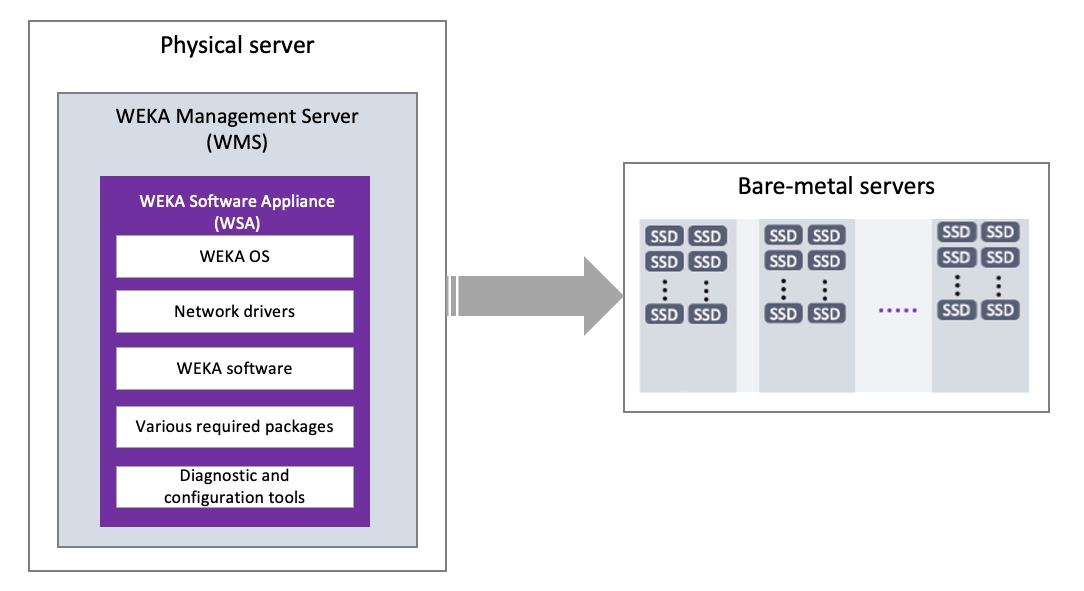
WMS deployment prerequisites
Using the WMS with WSA to install a WEKA cluster requires a physical server (or VM) that meets the following requirements:
Boot drives: One or two identical boot drives as an installation target.
A system with two identical boot drives has the OS installed on mirrored partitions (LVM).
A system with one drive has a simple partition.
Minimum boot drive capacity:
If not configuring LWH: SSD 141 GB (131 GiB).
If configuring LWH: See the SSD-backed storage requirements section in Deploy Local WEKA Home v3.0 or higher.
Boot type: UEFI boot.
Cores and RAM:
If not configuring LWH: minimum 4 cores and 16 GiB.
If configuring LWH, see the Server minimum CPU and RAM requirements section in Deploy Local WEKA Home v3.0 or higher.
Network interface: 1 Gbps.
Prerequisites for the target bare metal servers
Target servers must be Dell, HPE, Supermicro, or Lenovo. Other servers are not supported.
The RedFish interface must be installed, enabled, and licensed for all target servers.
The WMS must be able to connect over Ethernet to the following servers’ interfaces:
OS management interface, typically 1 Gbps. It must be connected to a switch.
Base Management Controller (BMC), such as IPMI, iDRAC, or iLO interfaces. The BMC interface must be configured with an IP address.
All the servers' dataplane interfaces must be connected to the switches.
The bare metal servers must conform to the Prerequisites and compatibility.
The bare metal servers must have an OS management network interface for administering the servers.
The boot type must be set to UEFI boot.
For cluster configurations exceeding 25 servers, it’s advisable to equip the WMS with an ETH interface of superior speed, such as 10/25/50 Gbps, during the installation phase. As an alternative, you could bond two or more 1 Gbps interfaces to increase the bandwidth. Once the installation phase is completed, a bandwidth of 1 Gbps is sufficient.
Before you begin
Before deploying the WMS, adhere to the following:
Obtain the WMS package. For details, see Obtain the WEKA installation packages.
The root password is
WekaServiceThe WEKA user password is
weka.io123If errors occur during installation and the installation halts (no error messages appear), use the system console to review the logs in
/tmp. The primary log is/tmp/ks-pre.log.To get a command prompt from the Installation GUI, do one of the following:
On macOS, type ctrl+option+f2
On Windows, type ctrl+alt+f2.
WMS deployment workflow
1. Install the WMS
Boot the server from the WMS image. The following are some options to do that:
Copy the WEKA Management Station ISO image to an appropriate location so the server’s BMC (Baseboard Management Controller) can mount it or be served through a PXE (Preboot Execution Environment).
Depending on the server manufacturer, consult the documentation for the server’s BMC (for example, iLO, iDRAC, and IPMI) for detailed instructions on mounting and booting from a bootable ISO image, such as:
A workstation or laptop sent to the BMC through the web browser.
An SMB share in a Windows server or a Samba server.
An NFS share.
To use PXE boot, use the WEKA Management Station as any other Operating System ISO image and configure accordingly.
Burn the WMS image to a DVD and boot it from the physical DVD. However, most modern servers do not have DVD readers anymore.
A bootable USB drive should work (follow online directions for creating a bootable USB drive) but has not been tested yet.
Once you boot the server, the WEKA Management Station installs the WEKA OS (Rocky Linux), drivers, and WEKA software automatically and unattended (no human interaction required).
Depending on network speed, this can take about 10-60 mins (or more) per server.

2. Configure the WMS
Once the WMS installation is complete and rebooted, configure the WMS.
Run the OS using one of the following options:
Run the OS through the BMC’s Console. See the specific manufacturer’s BMC documentation.
Run the OS through the Cockpit Web Interface on port 9090 of the OS management network.
If you don’t know the WMS hostname or IP address, go to the console and press the Return key a couple of times until it prompts the URL of the WMS OS Web Console (Cockpit) on port 9090.
Change the port from 9090 to 8051, which is the WMS Admin port.

Browse to the WMS Admin UI using the following URL:
http://<WMS-hostname-or-ip>:8501
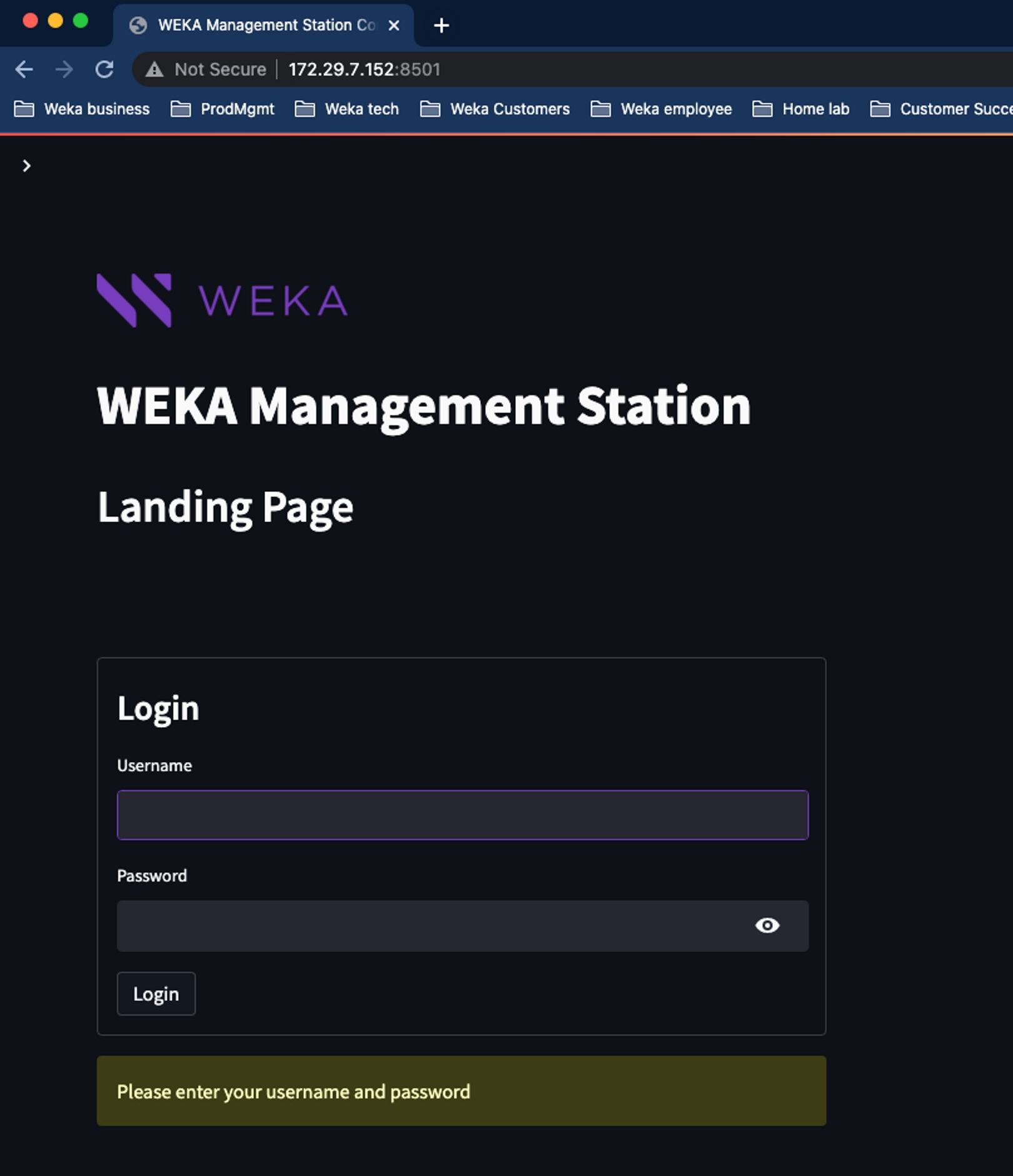
Enter username and password (default: admin/admin), and select Login. The Landing Page appears.
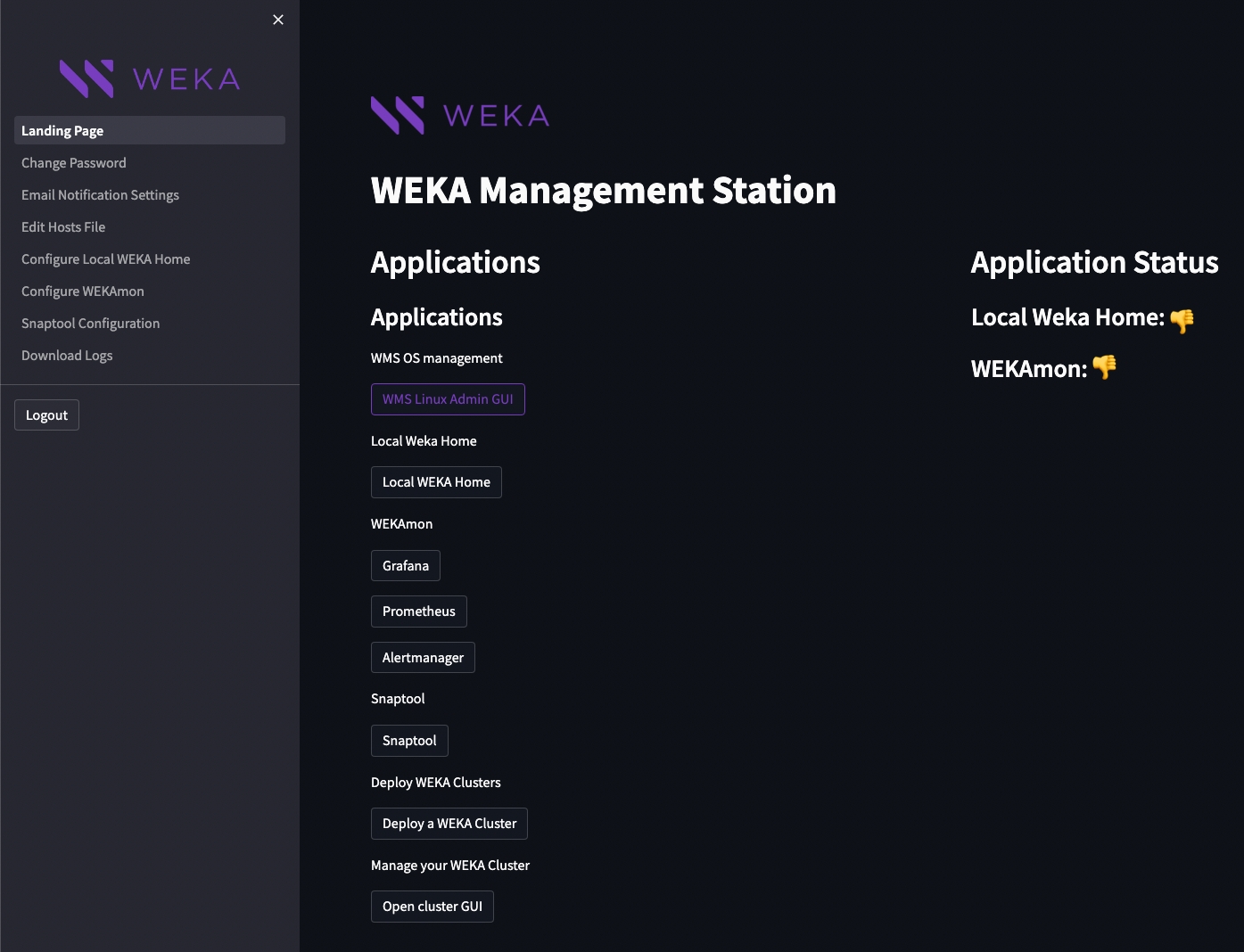
3. Add the WSA package to the WMS
Download the latest release of the WSA package from get.weka.io dashboard.
Copy the WSA package to /home/weka . For example:
scp <wsa.iso> weka@<wms-server>:
4. Install a WEKA Cluster
Go to the WMS Admin UI (landing page) and select Deploy a WEKA Custer.
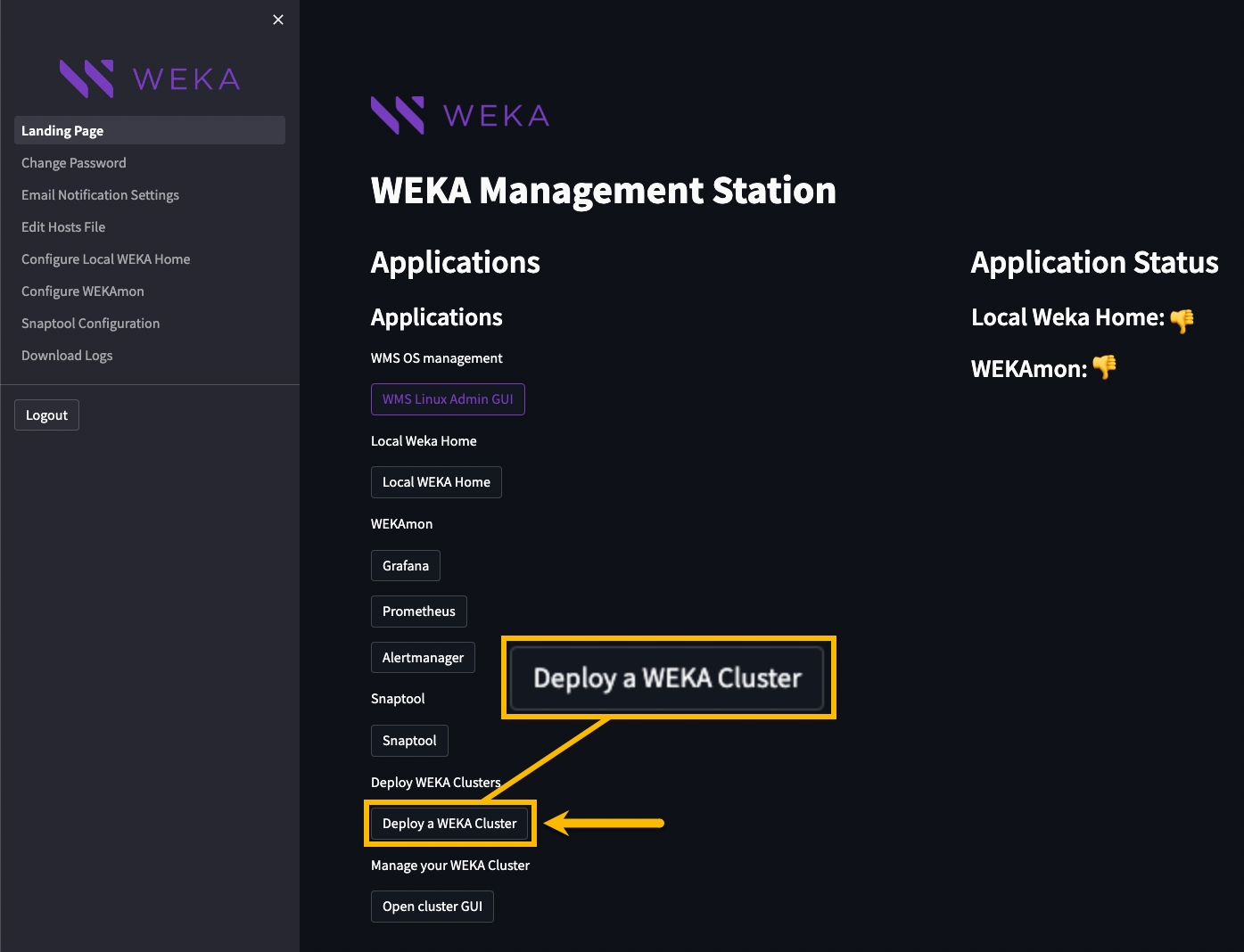
The WSA setup page opens.
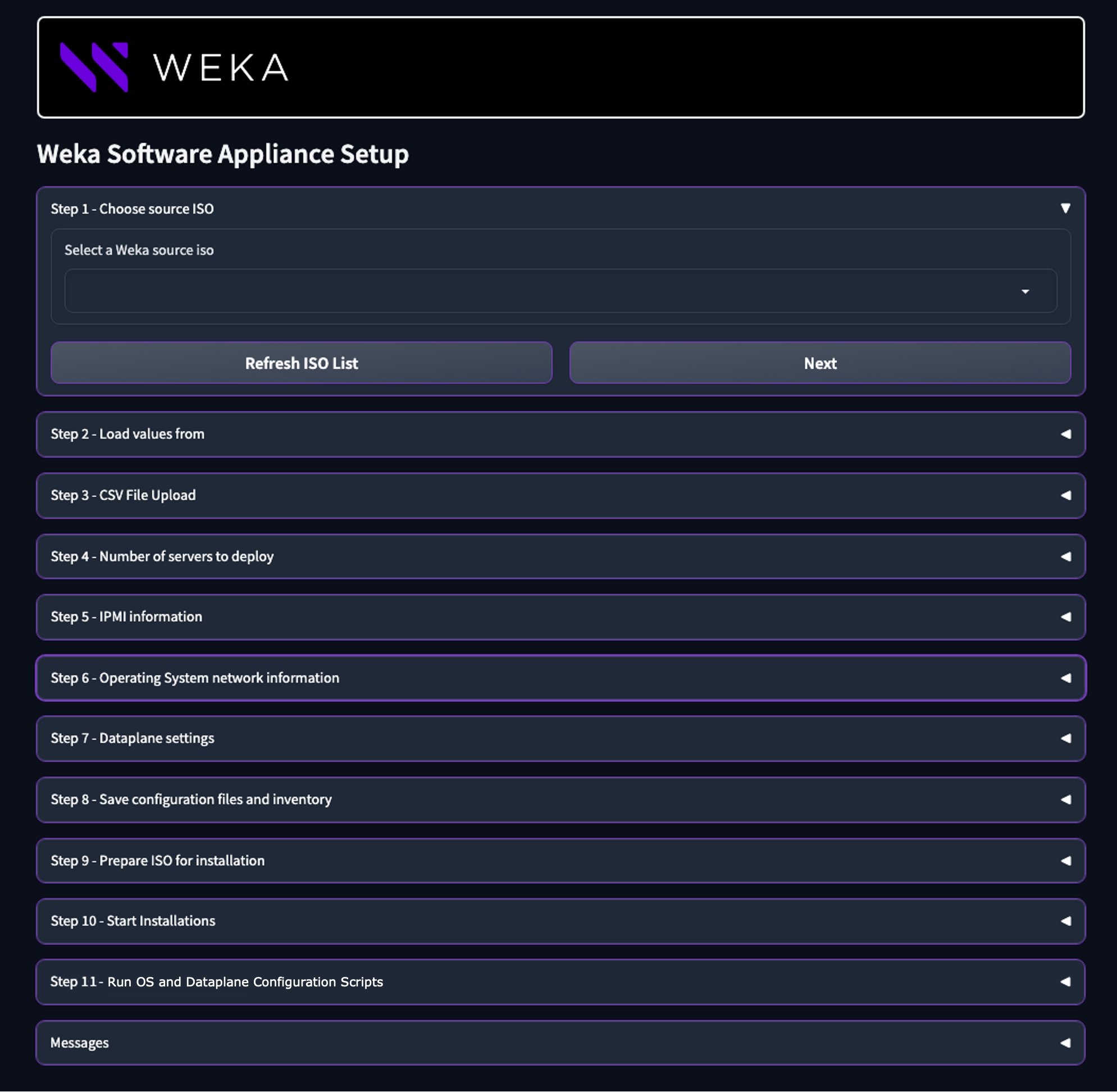
Open Step 1 - Choose source ISO, select the WSA package (ISO) you intend to deploy, and click Next.
In Step 2 - Load values from, select one of the following options:
Option 1: Enter environment data: Click Go directly to forms to enter data.
Option 2: Import CSV file: If you have the environment data in a CSV file, click Upload a CSV file to pre-populate data. Step 3 - CSV File Upload section opens.
Drag or click to upload the CSV file, and click Next.

CSV template example
You can prepare a CSV file with the columns as specified in the following example:
In Step 4 - Number of servers to deploy, enter a Server Count (default is 8), and click Next.

In the following steps, if you uploaded a CSV file, the data is pre-populated. You can review the data and if no editing is necessary, select Next.
In the IPMI First IP, enter the IPMI IP address of the first server. It requires a consecutive set of IP addresses for the servers (typical).
In the IPMI user and IPMI password, modify the login credentials for the IPMI, iLO, or iDRAC according to your choice.
Click Fill IPMI IPs to calculate the IP addresses for the number of servers specified in Step 4.
You can edit the IP addresses, Usernames, and Passwords as needed if the servers aren’t consecutive or require different credentials.
If you edited the table, click Verify IPMI IPs to verify that the WMS can log into the BMCs and detect the manufacturer (Brand column).
Verify that all is correct, and then click Next.
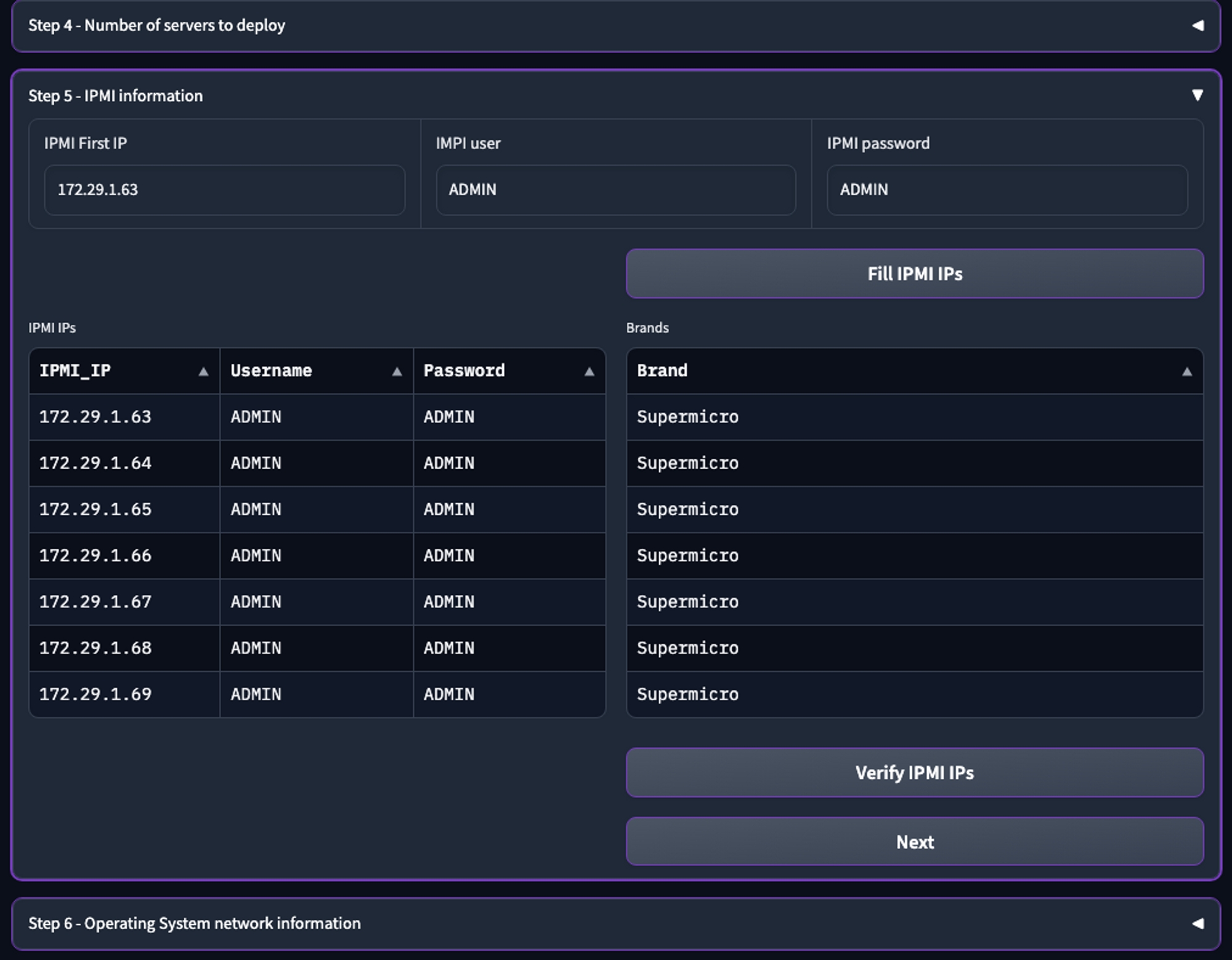
In Step 6 - Operating System network information, do the following:
In the OS First IP, enter the IP address of the OS 1 Gbit management interface. It requires a consecutive set of IP addresses for the servers (typical).
In the remaining networking fields, fill in the networking details.
Click Fill OS Table to populate the table. The WMS automatically generates names and IPs.
Verify that the OS IP settings are correct. You can repeatedly click Fill OS Table to make adjustments.
Verify that all is correct, and then click Next.
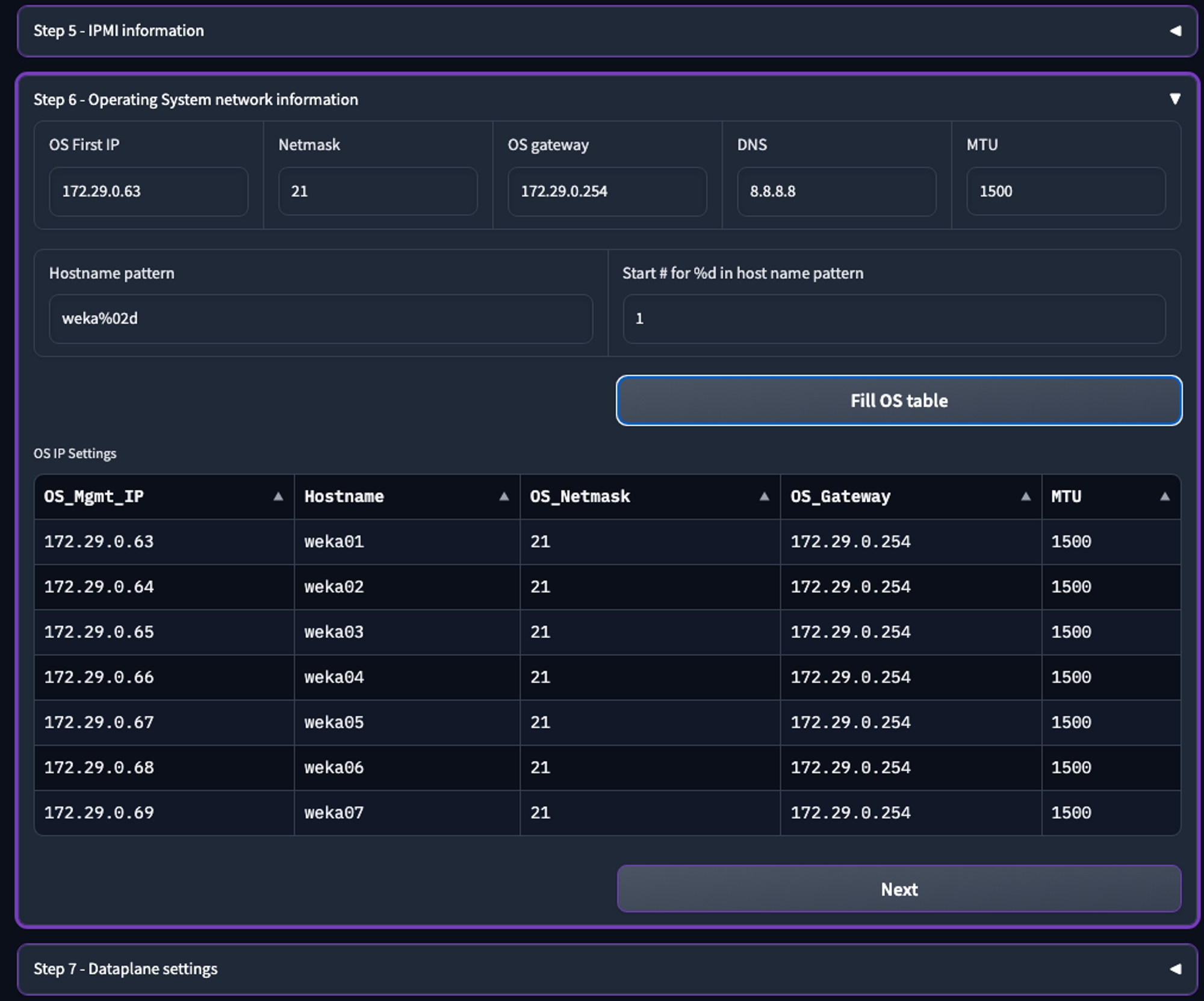
In Step 7 - Dataplane settings, do the following:
Set the number of interfaces in the Dataplane Interface Count slider.
In the remaining dataplane fields, fill in the details.
Click Update Dataplanes. The WMS automatically populates the data.
You can repeatedly click Update Dataplanes to make adjustments.
Verify that all is correct, and then click Next.
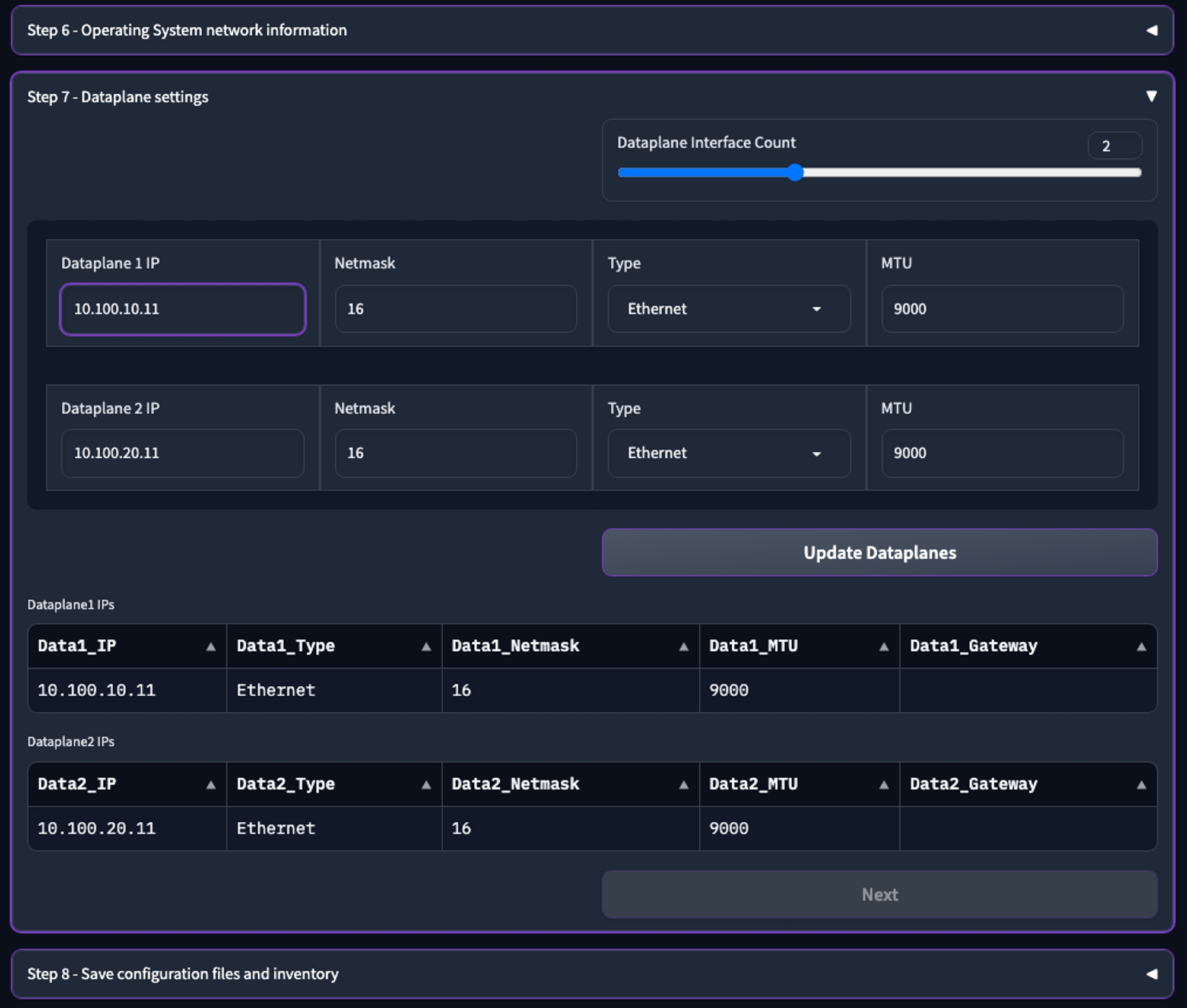
In Step 8 - Save configuration files and inventory, click Save Files to save the configuration files, and then click Next.
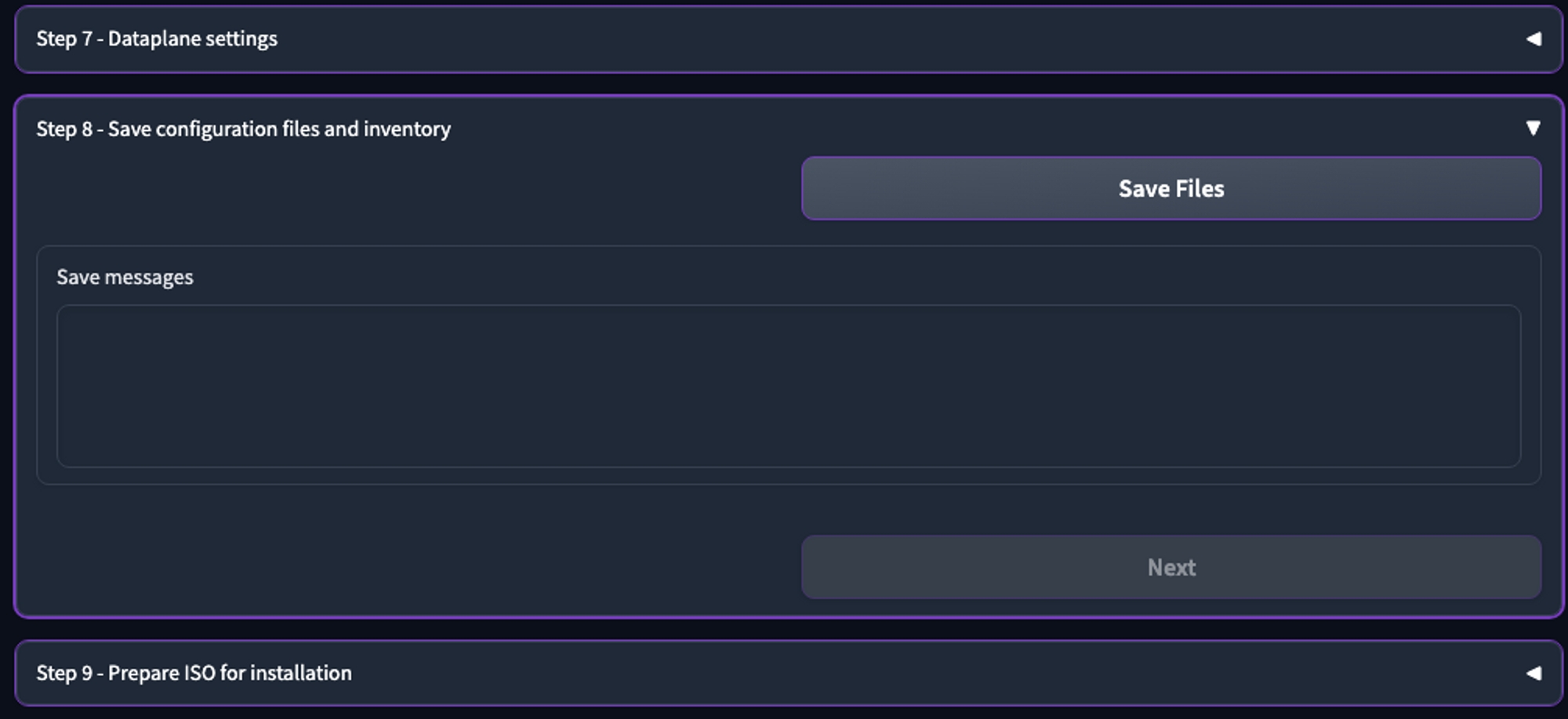
In Step 9 - Prepare ISO for installation, click Prepare ISO for install. The WMS updates the kickstart on the ISO to match the WMS deployment data (it takes about 30 seconds).
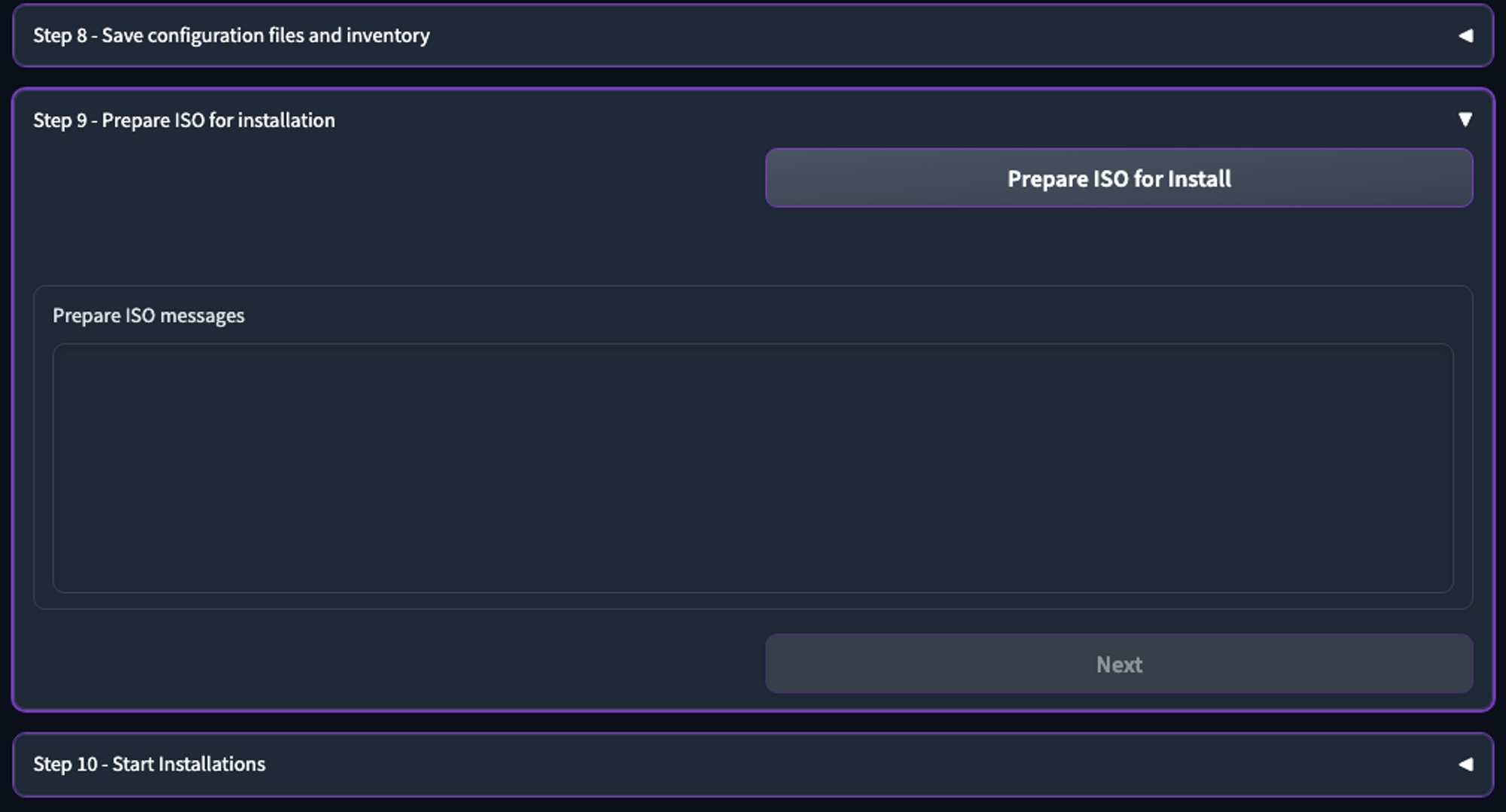
When the ISO preparation is completed, the output is displayed. Verify that no errors appear. Then, click Next.

In Step 10 - Start Installation, click Install OS on Servers. The WMS loads the WSA on the servers previously defined and starts the installation. The installation can take several minutes and displays output when complete. Verify that no errors appear.

The installation process takes about 30 minutes, depending on several factors, such as network speed. Verify that the server’s BMC completed the restart.
In Step 11 - Run OS and Dataplane Configuration Scripts, click Run post-install scripts. This action runs scripts to configure the servers with the specified dataplane IPs and perform additional tasks, such as populating
/etc/hosts.

Alternative OS and dataplane configuration
These commands only need to be run if you did not follow step 11 above.
Connect to one of the cluster servers to run the post-install scripts. The tools are in the same location:
/opt/tools/installon the WSA as they are on the WMS.
When prompted, enter the password
WekaServiceChange the directory to
/opt/ansible-installby running the following command:
Run the post-install script:
Example:
Ensure the DNS is operational, or copy the
/etc/hostsentries from one of the cluster servers to the WMS.
What to do next?
Last updated